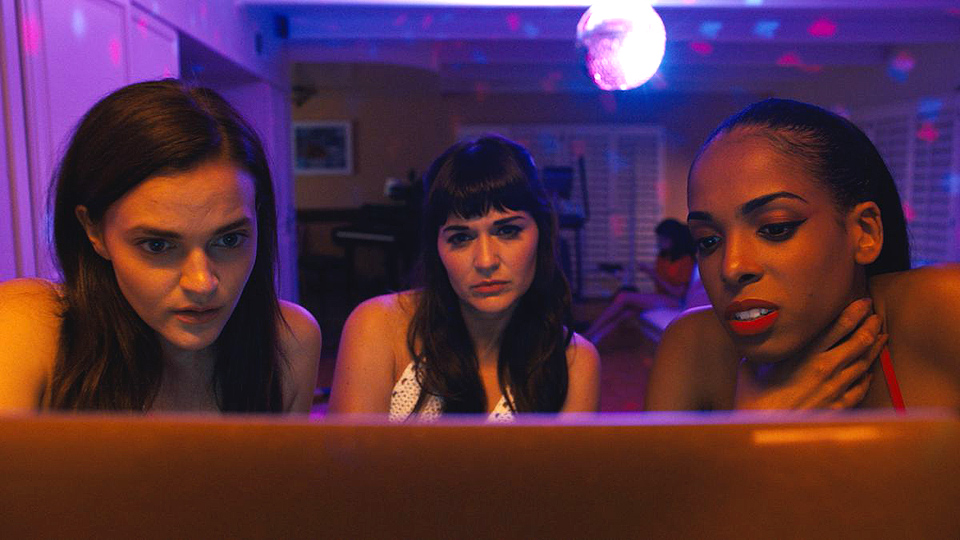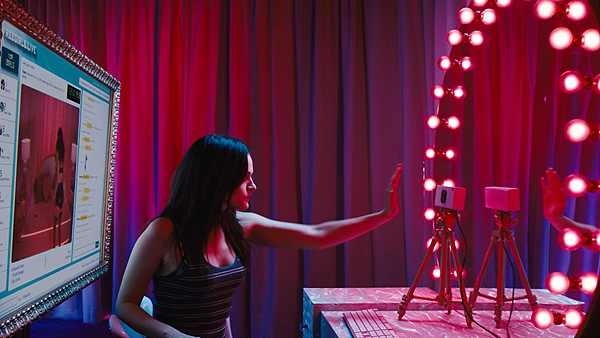
A common saying goes that sex work is considered the oldest profession, yet it also happens to be one where the workers are often the most exploited. Exploitation and safety on the job is a constant problem, with little protection. A system embedded with patriarchy and male supremacy doesn’t leave much space, without a fight, for women to be in full control of their bodies and livelihoods.
The horror genre also has shortcomings when it comes to portraying women, particularly those who engage in sexual acts, as more than props or bait for the killer. The unspoken rule in horror films is often that having sex– especially for women– in the movie is sealing one’s fate to die.
The new Netflix original film CAM, is subverting this horror trope, while showcasing an empowering narrative for sex workers, that allows them to be seen as human, worth protecting, and capable of being heroes in a glorious but bloody way.
CAM, directed by Daniel Goldhaber, stars Madeline Brewer as Alice, who is an ambitious webcam girl, who wakes up one day to discover she’s been replaced on her show with an exact replica of herself. The head writer of the film, Isa Mazzei, is a former webcam model, and has said that she drew on many of her own life experiences to create the screenplay.
“The general idea that I started with was to create a film where an audience would empathize with a sex worker, and from there I had to figure out, well, how do we do that,” Mazzei said in an interview when discussing the movie. It would seem she does this by drawing the audience into the world of webcam models, their struggles, and uses the thriller plot line as something of a metaphor of the stakes these women go through to protect their identity and lives.
In the film we’re allowed to see behind the curtain, or screen rather, of what these sex workers go through. Webcam models are video performers who stream their videos on the Internet. They often perform erotic and sexual acts online in exchange for money. Some operate from their homes, while others live in “studios” where they are managed by someone, usually a man, who takes a percentage of their earnings. During the webcam broadcast they solicit money tips from viewers to engage with them as they film. Although some cam girls can make a lot of money doing this line of work, many do not, and often have to deal with stalking, harassment, and little protection of their wages, as companies such as PayPal, and the websites they stream on, often take enormous percentages of their earnings, or try to stop them from earning any money. On top of this, cam girls can deal with being shamed, just like other sex workers, for the work they do by family, friends, and the general public. CAM does a good job of giving glimpses of all of these struggles, as it interweaves real world problems of sex workers with the more horror-leaning plotline.
The character of Alice is no shrinking violet, and neither are the women she surrounds herself with. She’s shown as ambitious in her work of wanting to get a higher ranking in her profession, and wanting to become one of the most popular cam models on the website she streams on. We’re shown the long hours of labor she puts in to secure her ranking, and the frustration she goes through in the highly competitive environment. The interesting angle here is that often, in fictional narratives, sex workers can be portrayed as having no other choice but to do the line of work they find themselves in, and that they are down on their luck, and somehow broken individuals. They are made to be tragic figures to pity, root for them to somehow find another way of life, or to meet a man that will be their “savior” from this lifestyle.
The well-known film Pretty Woman comes to mind in that regard. CAM doesn’t do any of that. Alice isn’t broken, just driven, and has chosen this line of work, takes some pride in her success, and ultimately chooses to fight the unknown entity threatening her lifestyle as a webcam model. It’s a refreshing take on this character type, and allows for the viewer to see Alice as a layered and capable individual who is the active protagonist of her story, and not a passive person that the story just happens to.

There’s also diversity in the film in that the girls showcased come in all races and body types. We don’t get to know all the stories of the workers that Alice is friends and frenemies with, but from her interaction with them it helps in creating an atmosphere that shows there are real people involved with different personalities and thoughts. Sex workers, like any groupings of people, aren’t a monolith, and the film displays this.
Because the narrative is from Alice’s perspective, the film does a good job of breaking away from the often catered-to male gaze in filmmaking. The nudity and sexual acts don’t come off as gratuitous and exploitative. The women are sexual, but often times it’s shown as simply being part of the work, almost technical and strategic. Being that this is a film where a sex worker is the main character, the movie could have easily descended into constant bare breasts shots (although many of the women characters have rules against nudity actually), and drawn out scenes of webcam sessions, but it thankfully doesn’t fall into this trap.
Even with all of this innovative storytelling that humanizes sex workers, the film is still categorized as a horror movie, so it’s necessary to determine if it does its job in that regard as well. CAM isn’t exactly a horror movie, but rather a quality thriller that borders on horror. It’s not overt and bloody in the scary moments and what the actual “monster” in the movie is, but it does a good job of building a mystery, and the climax to that mystery is both satisfying and eerie. At a little over an hour and a half long, the film covers a good amount of ground, but doesn’t overstay its welcome.
One could argue that it’s a scary time to be a sex worker in the United States of America. Just months ago GOP president Donald Trump signed into law a new bill, that was a combination of the Stop Enabling Sex-Trafficking Act (SESTA) and the Fight Online Sex Trafficking Act (FOSTA), that makes online platforms now liable for content uploaded by their users. Since the time it was passed this year, dozens of online platforms that sex workers utilized to advertise their services, and do client screenings, either changed their terms of service, blocked access from the United States, or shut down completely. This has made it harder for these workers to receive their wages, and continues the practice of criminalizing the workers and leaving the profession open for trafficking and exploitation.
It would seem CAM takes this constant fear of losing one’s livelihood, and trying to survive, that many sex workers, and workers in general, deal with, and uses the horror narrative to be a metaphor of this struggle, and does a good job in doing so. It doesn’t bludgeon the viewer over the head with messaging, but the messaging is there, but done in an entertaining way.
CAM is currently streaming on Netflix. The trailer can be viewed here.












Comments